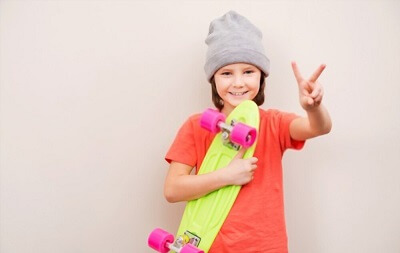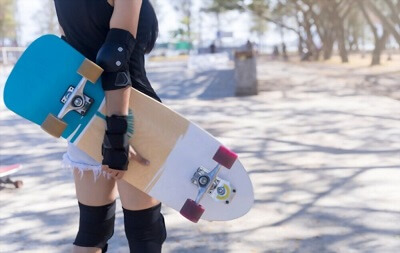Welcome, young skateboard enthusiasts! Are you ready to learn how to hold a skateboard like a pro? Well, you’ve come to the right place! Holding your skateboard may seem like a small detail, but trust me, it’s an essential skill that sets the foundation for everything you’ll do on your board. So, let’s dive in and discover the proper way to grip your skateboard.
Now, holding a skateboard may sound simple, but there’s actually a bit of technique involved. You want to start by placing your front foot on the skateboard’s grip tape, positioning it just behind the front bolts. Be sure to angle your foot slightly diagonally to give yourself more control. As for your back foot, it’s going to rest on the tail of the board, ready to provide that crucial pop when you want to perform tricks. Got it so far?
Okay, here’s the secret sauce: your grip. Having a solid grip is crucial for maintaining stability and control. To achieve this, use your front hand to wrap around the skateboard’s nose while your back hand rests on the side of the board. Find a grip that feels comfortable and secure for you, whether it’s holding the skateboard with your fingers or using your palm for more stability. Experiment a little and find what works best.
So there you have it, my skateboarding amigos! The basics of how to hold a skateboard are now in your brain bank. Remember to keep practicing, and don’t be afraid to try different grips until you find the one that feels just right for you. Stay tuned for more skateboarding tips and tricks that’ll have you shredding like a pro in no time. Happy skateboarding!
Mastering the Art of Skateboard Holding: A Step-by-Step Guide
- Begin by placing your dominant hand on the front of the skateboard, fingers spread wide for stability.
- With your other hand, grip the skateboard’s tail firmly to ensure control.
- Hold the skateboard close to your body, aligning it parallel to the ground.
- Maintain a relaxed yet firm grip to avoid dropping the skateboard.
- Practice holding the skateboard in different positions to develop muscle memory and increase comfort.
Remember, proper skateboard holding is essential for balance and maneuverability. Now you’re ready to conquer the skate park!

How to Hold a Skateboard: Find Your Perfect Grip
The Importance of Proper Grip
When it comes to skateboarding, one of the most fundamental skills you need to master is how to hold your skateboard. The way you grip and control your board can greatly impact your balance, stability, and overall performance. Whether you’re a beginner or an experienced skateboarder looking to improve your technique, understanding the proper way to hold a skateboard is essential.
The grip on your skateboard not only helps you maintain control, but it also allows you to execute tricks and maneuvers with precision and style. It serves as a connection between you and your board, giving you the confidence to push your limits and explore new tricks.
In this article, we’ll guide you through the different ways to hold a skateboard, explaining the benefits of each grip and providing tips on how to choose the grip style that suits your riding style and preferences.
Basic Grips: Regular and Goofy
Before delving into the various grip styles, it’s essential to understand the basics – regular and goofy stances. These terms refer to how you position your feet on the skateboard. A regular stance involves placing your left foot at the front of the board and pushing with your right foot. On the other hand, a goofy stance is the opposite, with your right foot at the front of the board and pushing with your left foot.
Figuring out your natural stance is crucial as it determines how you hold the skateboard and execute tricks. To determine your stance, try standing on a flat surface and have someone gently push you from behind. Whichever foot you instinctively step forward with will be your lead foot on the skateboard. Once you’ve determined your stance, you’ll have a better understanding of how to hold your skateboard.
Keep in mind that there’s no right or wrong stance – it’s all about what feels comfortable and allows you to perform at your best. Both regular and goofy stances have their advantages, and many skaters are ambidextrous and skilled in both.
1. The Standard Grip: The Classic Way to Hold a Skateboard
The standard grip, also known as the “classic” grip, is the most common way skateboarders hold their boards. This grip involves placing your back hand on the tail of the skateboard and your front hand on the nose. Your fingers should curve around the edge of the board, ensuring a secure hold.
When holding your skateboard with a standard grip, it’s crucial to maintain a firm and balanced hold. Your grip should be strong enough to keep control of the board, but not too tight that it restricts your movements. Having a loose and flexible grip allows you to maneuver the board more easily, making it ideal for performing tricks and spins.
Overall, the standard grip is the go-to for many skateboarders due to its versatility and ease of use. It provides a solid foundation for learning and executing various tricks, making it a great starting point for beginners.

2. The Power Grip: Enhanced Stability and Control
If you’re looking for maximum stability and control, the power grip might be the grip style for you. This grip involves placing both of your hands on the sides of the skateboard, near the middle of the board. Your fingers should wrap around the edges, creating a strong and secure grip.
The power grip provides enhanced stability, especially when riding at high speeds or navigating rough terrain. It allows for precise control over your board, making it ideal for downhill riding or freestyle skating. With both hands positioned on the sides, you have the ability to respond quickly to changes in direction or obstacles on the ground.
While the power grip offers excellent stability, it may limit your ability to perform certain tricks that require more hand movement. It’s best suited for riders who prioritize control and stability over maneuverability and trick execution.
3. The Finger Flip Grip: Perfect for Flip Tricks
Flip tricks, which involve spinning or flipping the skateboard while in the air, require a specialized grip that facilitates quick and precise hand movements. The finger flip grip is specifically designed for executing flip tricks with ease and accuracy.
To perform the finger flip grip, place your back hand on the tail of the skateboard as you would with a standard grip. However, instead of placing your front hand on the nose, position it slightly behind the front bolts of the board, with your fingers pointing towards the center of the board’s width.
With this grip, you have better control over the board’s flip and rotation during tricks. Your front hand acts as a pivot point, allowing you to flick or slide your fingers to initiate and guide the flip. This grip style is commonly used for tricks like kickflips, heelflips, and varial flips.
4. The Casper Grip: Unconventional and Unique
If you’re feeling adventurous and want to experiment with a unique grip style, then the Casper grip might pique your interest. The Casper grip involves holding the skateboard between your legs, upside down, with your feet resting on the trucks.
By using your thighs and knees to secure the board, you have the freedom to use both hands for tricks, grabs, and rotations. The Casper grip is a favorite among freestyle skateboarders looking to push the boundaries and add a creative twist to their riding.
It’s important to note that the Casper grip requires a high level of balance and control, as you’re essentially riding with your feet off the board. This grip style is not recommended for beginners or riders looking for stability, as it requires advanced skills and a deep understanding of the board’s mechanics.
Sideways Grip: For Certain Tricks and Slides
In certain situations, such as executing certain tricks or slides, a sideways grip may be necessary. This grip involves holding the skateboard sideways with one hand and using your other hand for balance or to execute a specific trick. It allows for unique maneuverability and provides an alternative approach to riding your skateboard.
Benefits of a Proper Grip
Having a proper grip on your skateboard offers numerous benefits. It enhances your balance, stability, and control, allowing you to perform tricks with precision and confidence. It also ensures the safety of both you and those around you, as a secure grip reduces the chances of the board slipping out of your hands or flying off in unpredictable directions.

Tips for Finding Your Ideal Grip Style
Experiment with different grip styles and stances to find the one that feels most comfortable and natural to you. Consider your riding style and the type of tricks you want to perform, as different grips cater to different skateboarding disciplines. Don’t be afraid to get creative and try unconventional grips like the Casper grip to discover new possibilities and challenge yourself.
The Importance of Grip Tape
While this article has focused on how to hold the skateboard with your hands, it’s worth mentioning the significance of grip tape. Grip tape is a gritty adhesive material that covers the top surface of your skateboard deck. It enhances traction, providing a reliable grip for your feet while riding.
Conclusion
Mastering the art of holding your skateboard is essential for any skateboarder, beginner or advanced. It determines your stability, control, and overall riding experience. By understanding different grip styles and experimenting with them, you can find the perfect grip that suits your preferences and allows you to push your skateboarding skills to new heights. So, grab your board, find your ideal grip, and get ready to ride!
Key Takeaways: How to Hold a Skateboard
- Stand with your feet shoulder-width apart on the skateboard.
- Bend your knees slightly for better balance.
- Hold the skateboard with one hand on each side of the deck.
- Keep your grip firm but relaxed to maintain control.
- Always be aware of your surroundings while holding the skateboard.
Frequently Asked Questions
Are you looking to learn how to hold your skateboard properly? Here are some common questions and their answers that will help you understand the correct way to hold a skateboard.
1. How do I hold a skateboard without a grip tape?
Holding a skateboard without a grip tape can be a little tricky, but it is possible. To do this, start by placing one hand near the middle of the deck, fingers underneath the board and your thumb on top. Use your other hand to hold the nose or tail of the skateboard, whichever feels more comfortable to you. This grip will provide you with better control and stability, even without the grip tape.
Remember, it’s important to have a firm but relaxed grip. Avoid gripping the skateboard too tightly, as it may restrict your movement and make it difficult to maneuver the board.
2. Should I hold my skateboard with gloves?
Using gloves while holding your skateboard is optional and depends on your personal preference. Some skateboarders like to wear gloves, especially when doing tricks or slides that put extra pressure on their hands. Gloves can provide extra protection and help prevent blisters or abrasions. They can also offer better grip and control, especially if they have specialized material on the palm.
If you choose to use gloves, make sure they fit properly and are comfortable to wear. Test them out before skateboarding to ensure they don’t restrict your movement or interfere with your ability to hold the skateboard securely.
3. Can I hold my skateboard by the trucks?
While it’s possible to hold a skateboard by the trucks, it’s generally not recommended. Holding it by the trucks can put unnecessary pressure on them and may cause damage over time. Additionally, holding the skateboard by the trucks can make it harder to maintain a steady grip and control over the board.
It’s best to hold the skateboard by the deck instead. Grip the skateboard firmly with one hand on the underside of the deck and the other hand on top near the nose or tail. This grip provides better stability and control over the skateboard while minimizing the risk of damaging the trucks.
4. How should I hold my skateboard when carrying it?
When carrying your skateboard, the most common and recommended method is to hold it by the underside of the deck. Place one hand on the underside, near the middle of the board, with your fingers underneath and your thumb on top of the deck. Use your other hand to support the skateboard from the side, near the nose or tail.
Make sure to keep a firm grip, but also ensure you have enough flexibility in your fingers to adjust your hold as needed. This grip allows for better balance and control while carrying the skateboard, making it easier to navigate through crowds or uneven surfaces.
5. Should I hold my skateboard differently when going up or down stairs?
When going up or down stairs with a skateboard, it’s essential to adjust your grip to ensure better control and stability. Instead of holding the skateboard by the underside of the deck, consider holding it by the trucks. This grip provides more leverage and control over the board, making it easier to navigate the stairs.
Place one hand on the trucks near the wheelbase, securing a firm grip. Your other hand can be used to support the skateboard from the side, near the nose or tail. By holding the skateboard this way, you’ll be able to distribute your weight evenly and maintain better balance while going up or down the stairs.

Summary
Holding a skateboard is important for safety and balance while skateboarding. To hold a skateboard correctly, place your back foot on the tail and your front foot near the bolts. Keep your knees slightly bent and your weight centered to maintain stability. When carrying your skateboard, hold it with one hand on the side of the deck.
Skateboarding is a fun and exciting sport, but it’s crucial to know how to hold your skateboard properly. By following these simple steps, you can ensure a safe and enjoyable skateboarding experience. So grab your board, find your stance, and get ready to shred!
(Special Note: Since you have to choose a good skateboard for beginners, we have shared the best beginner skateboards here so you can see them.)

